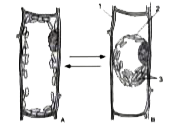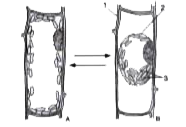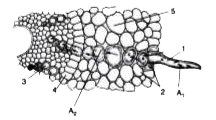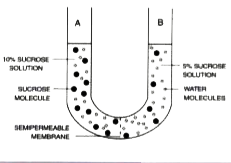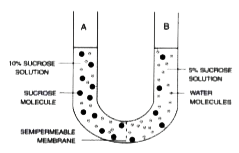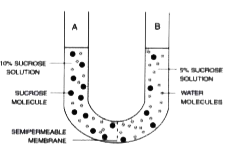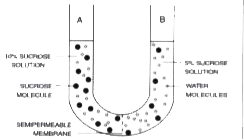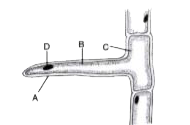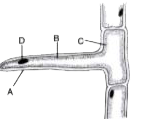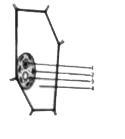REVIEW QUESTIONS from EVERGREEN BIOLOGY (ENGLISH) ABSORPTION BY ROOTS for Class 10
| Class 10 | BIOLOGY |
| Chapter | ABSORPTION BY ROOTS |
| EVERGREEN BIOLOGY (ENGLISH) | REVIEW QUESTIONS |
| Medium | English |
| Academic Year | 2023-2024 |
Question 71
Describe the mechanism which brings about the change in the structures depicted in A and B.

1. Cell wall
2 . Strong sugar solution
3 . Protoplasm
4 . Large vacuole
5. Nucleus
Study the diagram and answer the questions that follow:
What is the state of the cell shown in the diagram?View SolutionQuestion 72
Describe the mechanism which brings about the change in the structures depicted in A and B.

1. Cell wall
2 . Strong sugar solution
3 . Protoplasm
4 . Large vacuole
5. Nucleus
Study the diagram and answer the questions that follow:
Name the structure which acts as a selectively permeable membrane.View SolutionQuestion 73
Describe the mechanism which brings about the change in the structures depicted in A and B.

1. Cell wall
2 . Strong sugar solution
3 . Protoplasm
4 . Large vacuole
5. Nucleus
Study the diagram and answer the questions that follow:
What is the state of the cell shown in the diagram?View SolutionQuestion 74
Describe the mechanism which brings about the change in the structures depicted in A and B.

1. Cell wall
2 . Strong sugar solution
3 . Protoplasm
4 . Large vacuole
5. Nucleus
Study the diagram and answer the questions that follow:
If the cell in the diagram possessed chloroplasts, where would these be present ?View SolutionQuestion 75
Describe the mechanism which brings about the change in the structures depicted in A and B.

1. Cell wall
2 . Strong sugar solution
3 . Protoplasm
4 . Large vacuole
5. Nucleus
Study the diagram and answer the questions that follow:
Name any one feature of this plant cell which is not present in animal cells.View SolutionQuestion 80
The diagram given below represents an experimental set-up to demonstrate a vital process. Study the same and then answer the questions that follow :

Keeping in mind the root hair cell and its surroundings, name the part that corresponds to (1) concentrated sugar solution
(2) parchment paper and
(3) water in the beaker.View SolutionQuestion 85
The figure given below is a diagrammatic representation of a part of the cross-section of the root in the root hair zone. Study the same and then answer the questions that follow :

Draw a labelled diagram of the root hair cell as it would appear if some fertilizer is added to the soil close to it.View SolutionQuestion 103
The following paragraph is related to absorption of water from the soil. Copy and complete the following paragraph by selecting the correct word from those given in the box. You may use the term only once .

Water enters the root hair from the soil by the process of . .. .. ... .. . . This is because the solution in the soil is .............. ... whereas the cell sap in the root hair cell is .... ...... ...... The water then passes through the .... ............. cells by cell to cell .... .. ........ and reaches the xylem of the root.View SolutionQuestion 113
Given below are diagrams of plant cells as seen under the microscope after being placed in two different solutions :
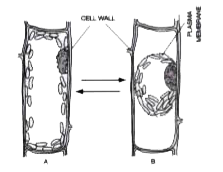
From the solutions given in brackets (water, strong sugar solution , 1% salt solution) name the solution into which :
(1) Cell A (2) Cell B was placed before being viewed under the microscope.View SolutionQuestion 117
Free enegry , G=H−TS, is state function that indicates whther a reaction is spontaneous or non-spontaneous. If you think of TS as the part of the system's enegry that is disordered already, then (H−TS) is the part of the system's energy that is still ordered and therefore free to cause spontaneous change by becoming disordered.
Also, ΔG=ΔH−TΔS From the second law of thermodynamics, a reaction is spontaneous if ΔtotalS is positive, non-spontaneous if ΔtotalS is negative, and at equilibrium if Δ'→talS is zero.
Since, −TΔS=ΔG and since ΔG and ΔS have opposite sings, we can restate the thermodynamic criterion for the spontaneity of a reaction carried out a constant temperature and pressure.
IF ΔG<0, the reaction is spontaneous.
If ΔG>0, the reaction is non-spontaneous.
If ΔG=0, the reaction is at equilibrium.
Read the above paragraph carefully and answer the following questions based on the above comprehension.
One mole of ice si converted to liquid at 273K,H2O(s) and H2O(l) have entropies 38.20 and 60.03Jmol−1K−1. Enthalpy change in the conversion will be View SolutionQuestion 134
A candidate in order to study the process of osmosis has taken 3 potato cubes and put them in 3 different beakers containing 3 different solutions. After 24 hours, in the first beaker, the potato cube increased in size, in the second beaker, the potato cube decreased in size and in the third beaker there was no change in the size of the potato cube. The following diagram shows the result of the same experiment :

Give the technical terms of the solutions used in beakers, 1 , 2 and 3 .View SolutionQuestion 135
A candidate in order to study the process of osmosis has taken 3 potato cubes and put them in 3 different beakers containing 3 different solutions. After 24 hours, in the first beaker, the potato cube increased in size, in the second beaker, the potato cube decreased in size and in the third beaker there was no change in the size of the potato cube. The following diagram shows the result of the same experiment :

In beaker 3, the size of the potato cube remains the same. Explain the reason in brief.View SolutionQuestion 136
A candidate in order to study the process of osmosis has taken 3 potato cubes and put them in 3 different beakers containing 3 different solutions. After 24 hours, in the first beaker, the potato cube increased in size, in the second beaker, the potato cube decreased in size and in the third beaker there was no change in the size of the potato cube. The following diagram shows the result of the same experiment :

Write the specific feature of the cell sap of root hairs which helps in absorption of water.View SolutionQuestion 137
A candidate in order to study the process of osmosis has taken 3 potato cubes and put them in 3 different beakers containing 3 different solutions. After 24 hours, in the first beaker, the potato cube increased in size, in the second beaker, the potato cube decreased in size and in the third beaker there was no change in the size of the potato cube. The following diagram shows the result of the same experiment :

What is osmosis ?View SolutionQuestion 138
A candidate in order to study the process of osmosis has taken 3 potato cubes and put them in 3 different beakers containing 3 different solutions. After 24 hours, in the first beaker, the potato cube increased in size, in the second beaker, the potato cube decreased in size and in the third beaker there was no change in the size of the potato cube. The following diagram shows the result of the same experiment :

How does a cell wall and a cell membrane differ in their permeability?View SolutionQuestion 149
The diagram given below represents a plant cell after being placed in a strong sugar solution . Study the diagram and answer the questions that follow:

How can the above cell be brought back to its original condition? Mention the scientific term for the recovery of the cell.View Solution



